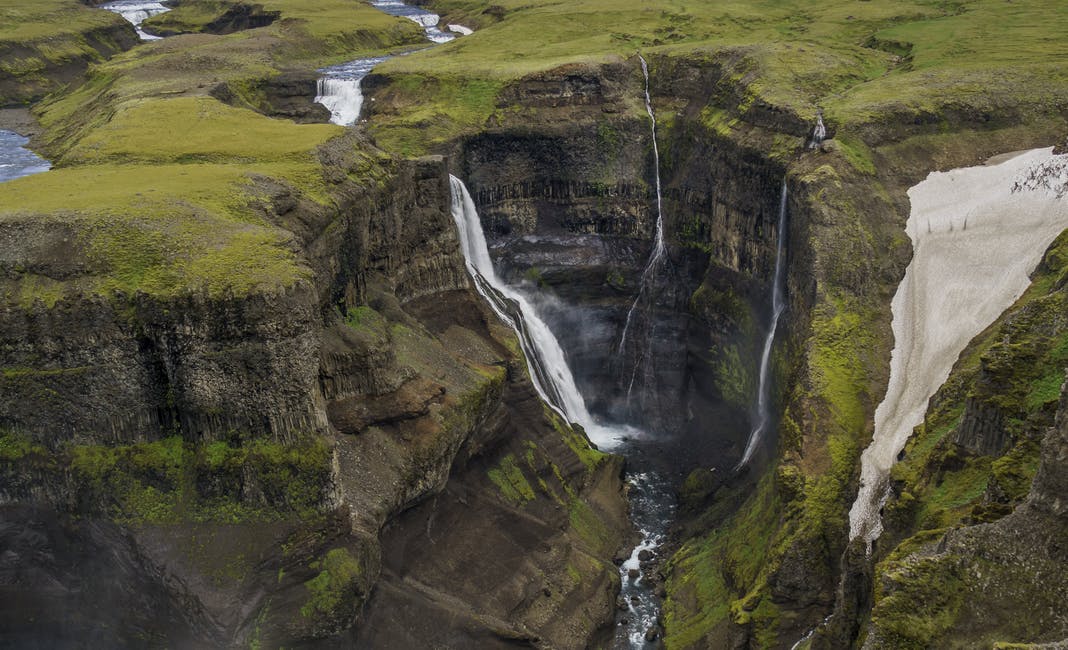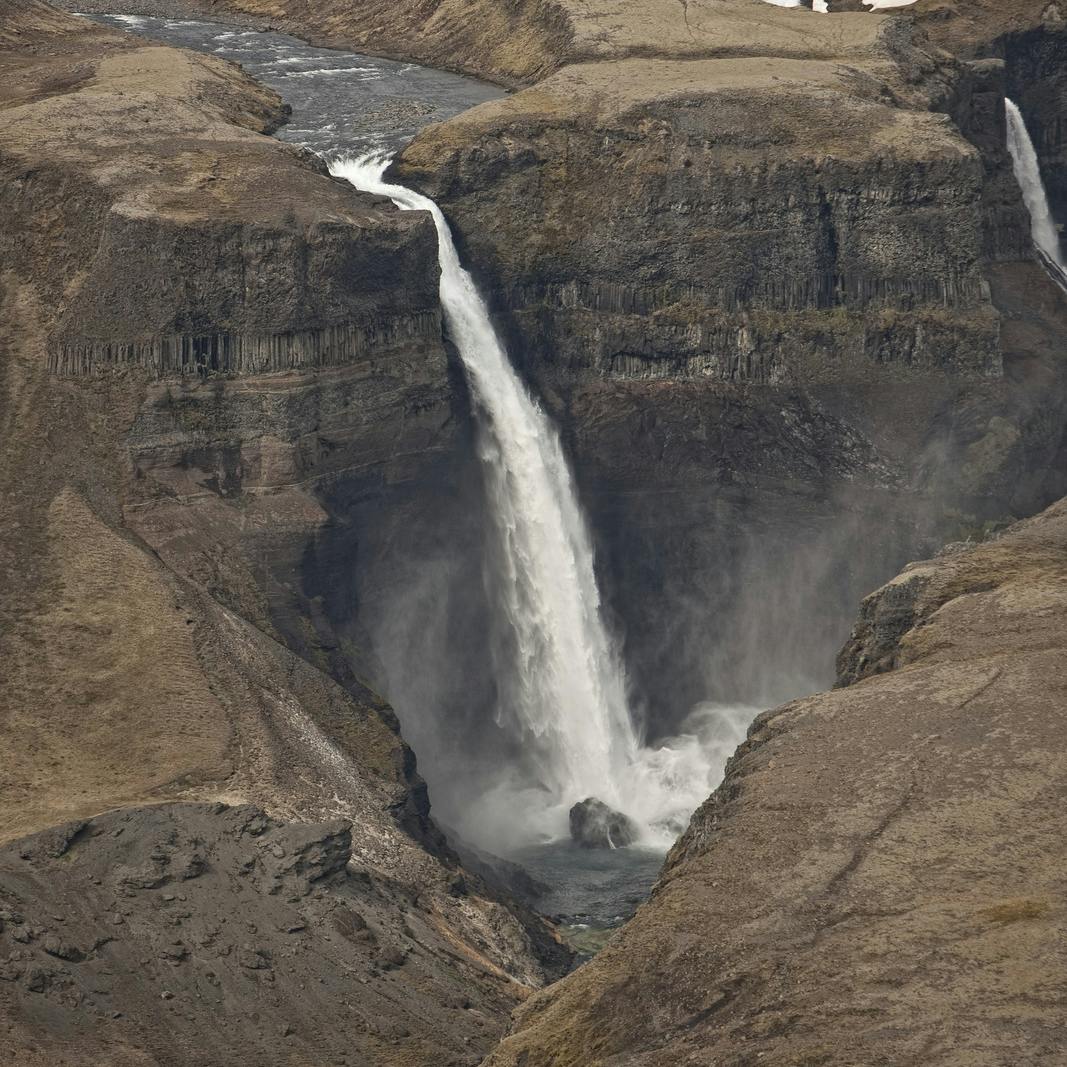
Guide to Háifoss Waterfall in Iceland
Háifoss, one of Iceland's majestic natural wonders, stands as a testament to the country's breathtaking landscapes and captivating beauty. Nestled in the Þjórsárdalur valley, Háifoss is a powerful waterfall that plunges dramatically into the Fossá River below, creating a spectacle that captures the hearts of all who witness it.
The Fossá River feeds into the longest river in Iceland, the Þjórsá River. Þjórsárdalur, and Háifoss waterfall, is situated near the volcano Hekla in southern Iceland. With its awe-inspiring height of approximately 122 metres (400 feet), Háifoss ranks as one of the tallest waterfalls in Iceland, making it a must-see destination for nature enthusiasts and adventure seekers alike.
The name "Háifoss'' itself translates to "High Waterfall" in Icelandic, a fitting designation for a natural wonder that commands attention with its sheer vertical drop. Less than 250 metres away from Háifoss, there is another waterfall named Granni. This waterfall has a height of 101 metres (331 feet) and is less powerful than Háifoss. Granni is a shortened version of the Icelandic word "Nágranni'', translating to "Neighbour".
The name of this waterfall is based on its location, hinting at the neighbouring waterfall Háifoss. Until the early 19th century, the two waterfalls that are fed by the same river remained nameless. As the Fossá River tumbles over the cliffs, it creates a constant symphony of roaring water, echoing through the valley and immersing visitors in the grandeur of the surroundings.
Water in Háifoss
As mentioned, Háifoss is a result of the Fossá River falling over the high cliff. The Fossá River feeds into the longest river in Iceland, the Þjórsá River. This river runs through the south of the country, spanning 230 kilometres (143 miles). At Perlan Museum in Reykjavík, you can explore more about water in Icelandic nature. The Icelandic Museum of Natural History has numerous exhibitions, and one of them focuses on the diverse forms and bodies of water in Iceland. This exhibition is visual, lively and constantly evolving.
Háifoss in Icelandic Folklore

The vicinity surrounding Háifoss, much like many other parts of the country, is steeped in folklore. According to local tales, it was believed to be the abode of an ogress who, with a penchant for fishing, would catch trout from the falls and sternly warn anyone who ventured too close.
A group of travellers, including a teenage boy, set up camp along the riverbanks. One evening, the boy playfully tossed a rock into the water. Unbeknownst to him, this seemingly harmless act offended the ogress, who considered the land her own. Patiently awaiting the safety of nightfall, she stealthily approached the boy's tent, swiftly entered, and began dragging him out by his feet.
The commotion woke the boy's friends, and a dramatic tug-of-war ensued as they desperately tried to save his life. Without their timely intervention, the boy might have met the grim fate that befell many in Icelandic tales, succumbing to the ogress's deadly intentions. Fortunately, they managed to free him, but not without consequence—the boy suffered severe injuries and spent a month bedridden after the harrowing encounter.
While ogres and ogresses are not as prevalent in Icelandic folklore as trolls, which have purely Scandinavian origins, there are other instances of these mythical beings. One of the most renowned figures is Grýla, an ogress whose thirteen children, fathered by a troll, transformed into the mischievous Yule Lads, devilish counterparts to the conventional Santa Claus.
Grýla was notorious not only for her monstrous offspring but also for her colossal cat, known for snatching away children who failed to receive new clothes for Christmas. This peculiar tradition served as motivation for youngsters to diligently engage in sewing and knitting before the festive season, lest they fall prey to Grýla's insatiable appetite for the young.
Hiking at Háifoss
There are a few hiking trails getting to the bottom of Háifoss - it is recommended to hire a guide as even the easiest route is rocky and can be challenging.
The easiest way to hike to Háifoss starts at the waterfall's parking lot at the top of the canyon. Here, you will find a noticeable hiking trail leading in the western direction, taking you to the bottom of the waterfall. This hike will take about 1.5 hours to complete and is about 4 kilometres (2.5 miles).
How To Get To Háifoss From Reykjavík
The first thing to consider when wanting to visit Háifoss Waterfall is the type of vehicle you have. As a visit to this waterfall involves a journey into the Icelandic Highlands, it is highly recommended to take this trip only with a 4x4 vehicle. Seasonal changes and road conditions should also be checked up on before embarking on this journey.
Háifoss is located 142 kilometres (88 miles) from Reykjavík. The journey, under normal circumstances, takes about 2.5 hours. Here is a step-by-step guide to get to Háifoss from Reykjavík:
- Head east on Route 1 (The Ring Road) from Reykjavík.
- Continue on Route 1 until you pass through the town of Selfoss.
- About 14 kilometres out of Selfoss, take a left to Route 30.
- Route 30 eventually leads into the Þjórsársdalur valley.
Háifoss Waterfall FAQ

Do You Need a 4x4 To Get to Háifoss?
The roads leading to some Icelandic waterfalls, including Háifoss, can be rough and unpaved, making a 4x4 vehicle more suitable for the journey. It is essential to check the current road conditions and regulations before embarking on your trip.
What Is The Height of Háifoss?
The waterfall has an approximate height of 122 metres (400 feet).
How To Get to Háifoss Waterfall?
You would likely start from the Þjórsárdalur valley. To get there, you might take Route 1 (the Ring Road) and then turn onto Route 32. The road conditions and accessibility can change, so it is advisable to check for the latest information before your trip.
Where Is The Valley of Tears in Iceland?
Sigöldugljúfur, also known as the Valley of Tears, is a canyon located in the Highlands of Iceland. It is situated in the Þjórsárdalur valley, not far from the well-known waterfall Háifoss.
Popular articles

Reykjanes Volcanoes Overview
Enjoy a complete overview of the Reykjanes Volcanoes from 2021-2024. Learn about its geology, recent activity, and visitor tips for a safe, memorable experience.

Reykjanes Peninsula Volcanoes: Sundhnúksgígar Eruptions
The anticipated volcano has erupted in the Reykjanes Peninsula, the site is being called Sundhnúkagígar. See the historic insights on the seismic activity and volcanic eruptions.

Earthquakes in Iceland
Earthquakes in Iceland are a fact of life. Each year, hundreds of small tremors shake the earth, a reminder of the country’s position on a tectonic plate boundary.

Volcano Museums and Exhibitions in Iceland
If you don't manage to visit an actively erupting volcano in Iceland - Experience its force at one of these excellent volcano museums and exhibitions in Iceland.

Top 10 Places To See the Northern Lights in Iceland
You can see the northern lights across the country, but some spots are more suitable than others. Find the best place to see the northern lights in Iceland.

Ice Caves From Reykjavik
Travel beyond the capital for a closer look at an ice cave under one of Iceland’s glaciers. If you can’t spare the time, experience Perlan’s ice cave in Reykjavik.